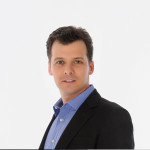By Doctor Olivier Claude
Hyaluronic acid is surgery’s best ally in the fight against facial aging. The latest-generation resorbable filler injections can be used in collaboration with cervicofacial lifts, thanks to their ability to restore the facial framework.
 This idea quickly became clear to me when I was working in the United States with Prof Michael Yaremchuk. The cervicofacial lifts were much more successful and longer-lasting when they were combined with the placing of small implants to rehang the tissues. These implants were inserted into the cheekbones or the top of the cheeks, or even into the corner of the jaw under the ear. This logical and innovative approach enables us to treat the gradual loss of deep fatty tissue and bone that we all suffer from as we age. The natural loss of deep volume is particularly noticeable on the upper and lateral parts of the face. This leads to the drooping or ptosis of the skin tissue downwards and forwards, where it gathers above the nasolabial folds and marionette lines or even the jowls.
This idea quickly became clear to me when I was working in the United States with Prof Michael Yaremchuk. The cervicofacial lifts were much more successful and longer-lasting when they were combined with the placing of small implants to rehang the tissues. These implants were inserted into the cheekbones or the top of the cheeks, or even into the corner of the jaw under the ear. This logical and innovative approach enables us to treat the gradual loss of deep fatty tissue and bone that we all suffer from as we age. The natural loss of deep volume is particularly noticeable on the upper and lateral parts of the face. This leads to the drooping or ptosis of the skin tissue downwards and forwards, where it gathers above the nasolabial folds and marionette lines or even the jowls.
The top part of the face thins out, especially the area around the eyes, and the lower third becomes heavier. We go from an inverted cone of youth to a bottom-heavy egg shape that adheres to the laws of gravity.
To treat sagging tissue, it would be a mistake to inject directly into the nasolabial folds or marionette lines, which drag the corners of the mouth downwards (“sad smiley” appearance). This would smooth out the grooves but further weigh down the face. Furthermore, this type of injection is often performed into the superficial tissue, which weighs down the tissues even more and hinders the movement of the facial muscles, creating unnatural-looking expressions.
The correct approach is to restore the structures that have changed. We need to recover the deep volumes that have been lost in the upper and lateral parts of the face. Note that this does not lead to the much-feared swollen face effect; on the contrary, it brings the face together by supporting it for an upwards and backwards lifting effect.
Deep injections into the cheekbones or top of the cheeks, or even into the corner of the jaw, also give a real tensing effect. This action is similar to restoring the framework of a house using pillars or joists. In this “renovation” project, restoring the deep facial structure is the foundation that enables us to achieve a long-lasting, natural-looking result. When dealing with any issues, we must treat the cause and not the consequences.
This physiological and mechanical approach to lifting the tissues is reinforced by the visual effect of lifting the face’s centre of gravity, for an added rejuvenating boost.
Once this structural work has been carried out, the rejuvenated and beautified face is naturally and harmoniously supported.
These cohesive hyaluronic acid injections sometimes enable patients to postpone surgery for a certain period of time. Patients must feel ready for a surgical face lift, and must be able to take a few days’ downtime from their work and social lives because of the swelling.
However, if the patient wants to enhance the results achieved with these injections − in particular in the oval, the neck or the eyelids – then surgery is the only solution. But only a light procedure is required, because the facial support framework will already have been treated using hyaluronic acid support injections. This systematic approach can reduce surgery time. The procedures carried out in the operating theatre only address the structures that need treatment, namely putting the tension back in the muscles (SMAS and the platysma muscle in the neck) as well as the skin.
The after-effects of surgery are reduced considerably in this approach, with only around ten days’ rest required in most cases.
The results are optimised through the balanced use of several tools: suitable surgery, cohesive supporting hyaluronic acid, gentle Botox, peels, etc. The results obtained are natural-looking, harmonious and long-lasting.
Should these injections be carried out before or after a cervicofacial lift? They are usually carried out at least two weeks before surgery. If additional injections are required, they are carried out at least 2 months after the lift.
What are the after-effects? The after-effects are not painful and slight swelling occurs only in very rare cases. Most patients can go back to work the following day.
How much do they cost? Expect to pay an average of between €900 and €2,500 for 2 to 3 sessions to restore the facial support framework.
 By Doctor Olivier Claude
By Doctor Olivier Claude












